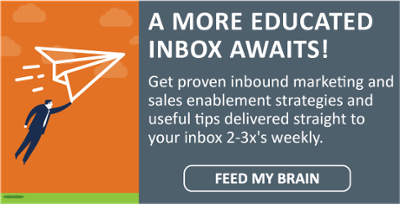Using a Survey for Lead Generation and New Business – Part V
 In a couple of weeks it will be time for Inbound Marketing 2015 and the skinny is that about 15,000 inbound marketers and HubSpot enthusiasts are going to show up.
In a couple of weeks it will be time for Inbound Marketing 2015 and the skinny is that about 15,000 inbound marketers and HubSpot enthusiasts are going to show up.
That’s a lot different from the first conference I attended back in 2011 where the attendance was about 1,000!
Over the years, I’ve gone to all of the conferences. A few years ago I went to a session at one of these where there was a presentation delivered by Rand Fishkin of SEOMOz, who talked about storytelling and how stories should be used as a centerpiece of inbound marketing.
Truth be told, most professional service firms are horrible story tellers and as a consequence, their content marketing efforts are boring, a hard read, and drier than Melba toast on a hot rock in the middle of summer in the desert.
But you can change things up when you use a survey as part of your firm’s content marketing and lead generation activities. Surveys produce lots and lots of compelling stories once you get beyond the statistics and dive into the relevance of the data for the different personas that are in your target market.
Best of all, those stories are the catalyst for inbound marketing that results in leads and new business. In other words, it’s not the data you’re going after when your CPA, consulting or AEC firm does a survey – it’s the potential of stories you find that you can turn into content and package into offers for lead generation.
Inbound Marketing for Lead Generation Starts at the Survey Design Process
 Inbound marketing requires marketers and partners to think five moves ahead when it comes to using surveys for lead generation. Even though you can’t produce content until results are collected and analyzed, you can start building the infrastructure you’ll need to convert respondents into leads and eventually new business.
Inbound marketing requires marketers and partners to think five moves ahead when it comes to using surveys for lead generation. Even though you can’t produce content until results are collected and analyzed, you can start building the infrastructure you’ll need to convert respondents into leads and eventually new business.
Here’s a list of 8 questions that marketers, niche practice leaders and business developers need to kick around the conference room table before the very first survey question moves down the path from lofty thought to survey question:
- What’s top of mind for our prospects and clients and how can we turn those issues into survey questions?
- What questions should we be asking that drive insight as to how to position our mix of services and products?
- What do we want to know about our respondents demographics (size, location, sales, etc.), so we can segment results for content marketing and lead generation?
- What type of content are we going to develop out of the survey results, and how are we going to package that content for lead generation purposes?
- How, when and where are we going to promote the availability of our content?
- What is our SEO strategy, particularly in regard to publishing a series of blog posts about survey results?
- How are we going to weave that content into a lead generation campaign that’s responsive to the sales cycle of our prospects – what type of offers can we construct for top, middle and bottom of the funnel lead generation?
- Who is going to be responsible and accountable for following up on warmer and more qualified leads?
And Now for Something Really Cool and “Inboundy”:
 If you are a SurveyMonkey AND HubSpot subscriber, you can integrate them together such that the demographics of the respondents and even their responses can be segmented for purposes of lead generation.
If you are a SurveyMonkey AND HubSpot subscriber, you can integrate them together such that the demographics of the respondents and even their responses can be segmented for purposes of lead generation.
OK, take a deep breath and let’s do some Marketing 401 work.
This integration means that I can use my HubSpot account, for example, to:
- Identify and segment all respondents with annual revenues greater than $5 million who said YES to question 6.
- Create an offer and landing page specific to the pain point being investigated in question 6.
- Use HubSpot’s email function to deliver a customized and personalized email with the offer to that segment.
- Look at how respondents who took the offer answered all survey questions right within HubSpot’s marketing or sales CRM.
- Put these respondents into a marketing automation campaign and deliver middle and bottom of the funnel offers as they convert into a qualified lead.
- Feed all of this info to my business development team ... if they’re not looped into HubSpot as they should be.
- Create a lead generation campaign specifically around the effort so that I can track and monitor results.
This Story Doesn’t End with This Blog Post
Just because my series about using surveys for lead generation is coming to an end doesn’t mean that the story is over.
It’s my hope that you’re seeing the huge upsides to incorporating surveys into your firm’s marketing program. Remember to plan early, get everyone to the table, and put the right infrastructure in place for lead acquisition and nurturing.
And last but not least, when it comes to creating content from survey results: produce compelling stories .. not just a rehash of survey data. Think pancakes with syrup rather than Melba toast!
.png)








Leave a Comment